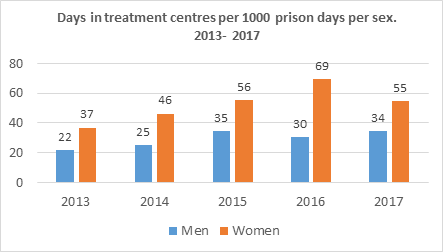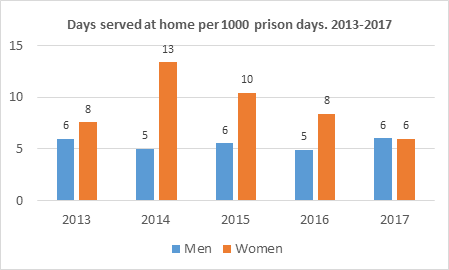Discrimination against women sentenced to prison in Norway is a myth

Discrimination against women sentenced to prison in Norway is a myth
Ragnar Kristoffersen
Researcher at the University College of Norwegian Correctional Service
Introduction
A Google search on the internet for women’s prison conditions in Norway results in more than 7000 Norwegian articles, the majority of them suggesting that conditions in prison are worse for women than men. The Public Services Ombudsman and the Equality and Anti-discrimination Ombudsman in Norway have shown great interest and concern for the so-called discrimination of women in Norwegian prisons. The Public Services Ombudsman has recently published a report on women’s prison conditions based on visits to two prison units for women and six prison units with mixed sexes.[1] The report states categorically that their findings demonstrate that women in general experience worse prison conditions than men do. However, the Public Services Ombudsman has not made a broad and systematic comparison between women and men's prison conditions. They only visited eight out of more than 60 prison units in Norway. Women served their sentences in 14 other prison units in Norway. The explicit purpose of the visits of the Ombudsman was to focus on, and uncover criticisable conditions relating specifically to women.
I will refute the widely accepted notion that imprisoned women are generally treated unfavourably. In order to reach substantiated and generally valid conclusions about the differences between the sexes it is necessary to compare similar conditions for both sexes. Ideally, one should look at data for the total prison population of both sexes, or at least data from representative samples. In my analysis, I will compare similar conditions for both sexes, and I will use annual data for the total prison population of both sexes. Furthermore, time series data will strengthen the ability to generalise about trends as opposed to time-dependent samples. In some examples, I will use five-year time series to demonstrate trends. Relative measures are also necessary, of which differences in actual time spent in prison is of critical importance. This particular aspect differs greatly among men and women in prison. The average sentence for imprisoned men and women is approximately eleven months and six months, respectively. It is also important to bear in mind that prison studies easily risk being flawed if they focus only on directly observable conditions and do not take into account the extent to which sentenced offenders serve part or the whole of the prison sentence at home or in a treatment institution. A study of the conditions of people sentenced to prison must also include prisoners granted access to various measures outside prison.
The purpose and scope of the article
I will present annual, national statistics on total prison populations related to important activities and measures offered both men and women during imprisonment, such as access to work, education, day-release, leave of absence, substance abuse treatment in and outside prison, programs, access to low security prison units, and serving at home with or without electronic monitoring.[2] It is essential to focus on these variables if valid comparisons of conditions are to be made. Combined, they are likely to make a big difference to any level of hardship and strain inflicted on the prisoners and on the possibilities of reintegration into society. It is the overall pattern – the total sum of these measures – which leads me to the conclusion that women sentenced to prison are not generally discriminated against. On the contrary, the data I will present supports the opposite conclusion; that women are treated more favourably, especially when we take into account the important and overlooked fact that women generally serve much shorter sentences. Only 95 of 1558 released prisoners (6 %) who served a prison sentence exceeding six months in 2018 were women. Therefore, it is easier for the prison authorities to implement activities and initiatives for men during their time in prison - and in many cases, it is also the appropriate thing to do, as there is reason to believe that negative consequences of a prison sentence are more likely to occur because of serving long sentences. Accordingly, one would expect that men sentenced to prison would receive more rehabilitative measures than women would. Surprisingly, my analysis discloses that the opposite is the case. To put it briefly: Women sentenced to prison spend less time in prison, but they receive more.
Reservations
It is important to bear in mind that my conclusion is not incompatible with claims that women in some aspects may serve under inferior conditions in some local prisons, materially or otherwise – for example in some prisons with mixed sexes, as the Ombudsman has pointed out. A systematic study of the material conditions for imprisoned men and women, such as the condition of the prison premises and exercise yards etc., is beyond the ambition and scope of this article. However, there is no doubt that many male prisoners also serve in inadequate, dilapidated prison units with unsatisfactory facilities that need to be improved. Moreover, 93% of prisoners are men, and any comparative study will naturally be affected by this imbalance. This implies that even when a comparatively smaller proportion of men may be affected by any disadvantage, men often still constitute a much larger group in absolute numbers. The relevance of relative measures describing the prison situation for men and women can therefore sometimes be questioned. Secondly, I have not taken into account the extent to which women serve their prison sentences geographically more scattered, leaving them, presumably, with a higher proportion serving in prisons a long distance from their home. This factor may for example reduce the number of visits from family. There is, however, no reason to believe that the problem of being far from home is unique to women. A brief look at zip codes belonging to male prisoners in Oslo and Bergen shows that half (205 of 413) do not live in the city area or in a nearby municipality. This number alone equals all imprisoned women today.
More men lack activation
Activation of prisoners is perhaps the most important indicator of any differential treatment of inmates by sex. The Correctional Service registers the number of days in which prisoners are employed. Table 1 shows the type of employment for men and women in prison in 2017 as a percentage of all day-work carried out. The figures are corrected for absence due to illness, leave of absence and refusal to work.
Table 1
Employment by sex 2017. % | Women | Men |
Industry/craft | 25,1 | 22,1 |
Forestry | 2,8 | 4,7 |
Service | 43,3 | 44,7 |
Education | 17,5 | 16,5 |
Day-release work | 4,2 | 4,2 |
Day-release school | 1,9 | 2,1 |
Other | 5,2 | 5,7 |
Total | 100,0 | 100,0 |
The proportion who lacked activation corrected for absence is an important piece of information, which is not included in the table. This was only 13% for women, compared to 20% for men. Given that men in general serve longer sentences, the opportunity to provide them with employment or education should be better than for women. This finding is therefore surprising.
Generally, table 1 shows that there are small differences in the gender proportions within the various registered activities. Women have a slightly higher proportion of employed persons in industry and crafts and a slightly larger proportion who received education. Day-release – daily exits from prison to work or school, an important rehabilitation measure – shows practically equal shares for the sexes. Although table 1 does tell us little about the quality of the activation of the sexes, the proportion of women who get education and day-releases is impressive compared to men when we consider the higher proportion of short sentences among women.
Women get more leave of absence
Leave of absence from prison is considered an important measure in order to keep contact with society outside, thus making a gradual reintegration into the community more feasible before release. Surprisingly, female prisoners get more leave than men do, despite the fact that they generally spend less time in prison. The proportion of registered days of leave per 1000 prison days was 29 % higher for women than for men in 2017. Ordinary leave of absence can only be granted after serving at least four months of a prison sentence. Considering that a higher proportion of men accordingly are entitled to such leave, one would expect the opposite result. On the other hand, crime type distribution among imprisoned women varies somewhat from imprisoned men, and it is likely that a larger proportion of women serve at longer distances from home. It is also possible that more men have further unsettled criminal charges against them. Such factors may have contributed to a more positive assessment of the women's leave applications. The fact remains that women get more leave of absence compared to men even though a higher proportion of men are eligible for such leave.
Women receive more treatment for substance abuse
The Ombudsman claims that women have lesser access to substance abuse treatment in prison. The two major forms of treatment for substance abuse are admissions to separate substance abuse treatment units inside prison or treatment in centres outside prison. 701 women were imprisoned in 2018, accounting for 9% of all admissions that year. There may be some inaccuracies in registration, but a review of registered data shows that 12% of those admitted to substance abuse units inside prison were women. The most important drug treatment measure, however, occurs in treatment centres outside prison, for shorter or longer periods, usually at least three months. Corrected for total time in prison per sex, women are offered a significantly higher proportion of this measure, and the proportion has been increasing in recent years.
Diagram 1 shows prison days in treatment centres per 1000 total prison days between 2013 and 2017, broken down by sex. In all the years, the proportion of women is higher than for men. The difference between imprisoned men and women may partly be explained by the seemingly accepted view that substance abuse problems are more frequent or possibly more severe among women than among men. However, recent research in Norway is inconclusive and can neither support nor oppose this hypothesis.[3] Overall, there is little evidence that there are significant differences in substance abuse between imprisoned men and women in Norway.
Diagram 1

Access to programs does not discriminate against women
Another important measure is group-based programs that target substance abuse and crime problems. According to release data in the years 2010-2014, approximately 5% of women started such a program, compared to just over 7% among men. However, it takes time to choose and motivate participants and to implement and complete these programs. Shorter stays in prison among women are therefore an important obstacle to providing such an offer to women. If we set a limit of at least six months' residence time in prison in order to be considered for program participation, the difference between men and women disappears. About 20% of women who were imprisoned for six months or more started a program, compared to around 19% among the men. In other words, women’s access to these programs is equal when we consider that programs cannot be offered to people with short sentences.
A larger proportion of women are allowed to serve in low-security prisons before release
An important objective for the correctional service is to be able to offer a gradual progression to more lenient conditions, which implies access to low security prisons in due time before release, especially for those with longer sentences. This is often referred to as the principle of progression. 75% of all women released in the years 2010-2014 were released from a low-security prison, compared to 65% for men. The difference can be partly explained by the fact that men serve longer prison sentences and more often for crimes that are more serious. Notwithstanding this, and contrary to the principle of progression, 25% of the released men were released from a high security prison, compared to only 15% of the women.
More women than men serve their sentence at home
Serving a part of a prison sentence – up to a half is possible – at home without electronic monitoring can be granted on special conditions towards the end of the sentence, which implies that you can stay in your home until ordinary release would have happened. Diagram 2 shows that the proportion of women being granted this attractive measure is higher than for men when corrected for the total time served in or outside prison. The proportion has admittedly decreased in recent years to a more equal level between the sexes.
Diagram 2

Moreover, the entire prison sentence can be served at home with electronic monitoring if the prison sentence is four months or less. Women sentenced to prison also receive significantly more access to serving their entire prison sentence at home with electronic monitoring. A comparison of prison sentences of up to four months in 2017 shows that 61% of the female prisoners were allowed to serve the entire prison sentence at home with electronic monitoring. For men, this was only 42%. Although the difference can be partly explained by a larger proportion of shorter sentences among women and possible differences in risk assessment of breach of terms, the figures show that a considerably larger proportion of women are given the opportunity to serve short prison sentences outside prison.
Concluding remarks
Corrected for time spent in prison, a significantly smaller proportion of men get activation during imprisonment, and women get more substance abuse treatment despite the weakly substantiated claim that they have more severe substance abuse problems. They get more access to leave of absence despite regulatory restrictions that infringes their options, and they get more access to low security facilities and more access to serving parts or all of their prison sentences at home despite the principle of progression, which should help offset this unbalance between the sexes. To some degree, these differences can be explained by the perceived severity of crime and differences in assessments of risk or individual needs, possibly related more often to women, such as serving in a prison at long distance from home.
In addition, we probably need a cultural explanation. For more than forty years, the dominant narrative about discrimination in Norway has been the discrimination against women. Despite many years of full legal equality between the sexes, the Equality and Discrimination Act still states that the law specifically aims to improve the position of women.[4] Working for the improvement of women’s position has been an integral and internalized part of the Norwegian culture for so many years that we cannot rule out that this more or less consciously plays an important role in the treatment of women sentenced to prison. This may explain to some extent why women are treated more favourably.
Today, a great deal is invested in improving women's prison conditions. The Directorate for the correctional service has created a special strategy aimed at improving the conditions for women in prison.[5] My analysis shows that women are overall better off in relation to access to the most beneficial measures aimed at reintegration into society. Of course, these findings do not deny that women can, in some prisons, experience inferior conditions compared to men, or – as the Ombudsman has pointed out – that they may have special needs that should be addressed. However, there is no reason to forget that men also have special needs that should be met. Reoffending is for example twice as prevalent among released men as among women.[6] We cannot rule out the possibility that favourable treatment of women may contribute to this result. Men commit 95% of all suicides in prison, and men totally outnumber women when it comes to longer periods of potentially harmful isolation in prison. In conclusion, the above does not indicate a need to concentrate less on the situation for men in prison.
How to cite this blog post (Harvard style)
Kristoffersen, R., (2019) Discrimination against women sentenced to prison in Norway is a myth. Available at https://www.compen.crim.cam.ac.uk/Blog/blog-pages-full-versions/discrimination-against-women-sentenced-to-prison-in-norway-is-a-myth (Published 1.7.2019)
[2] National Prison Registries of Norway are my sources, unless otherwise stated.
[3] Bukten, A. et. al. (2016). «Rusmiddelbruk og helsesituasjon blant innsatte i norske fengsel». Report 2/2016. Senter for rus- og avhengighetsforskning (SERAF). University of Oslo. The report is available here: https://www.med.uio.no/klinmed/forskning/sentre/seraf/publikasjoner/rapporter/2016/nedlastinger/seraf-rapport-nr-2-2016-rusmiddelbruk-og-helsesituasjon-blant-innsatte.pdf However, a recent cross-country study of ten high-income countries showed that drug abuse disorder was higher in women, but there was substantial cross-study heterogeneity: Fazel, S., Yoon, I. A., & Hayes, A. J. (2017). Substance use disorders in prisoners: an updated systematic review and meta‐regression analysis in recently incarcerated men and women. Addiction, 112(10), pp. 1725-1739.
[5] The strategy can be downloaded on this site: https://www.kriminalomsorgen.no/strategi-for-kvinner-i-varetekt-og-straffegjennomfoering.6004438-237613.html
[6] Graunbøl, H.M. et al. (2010). «Retur. En nordisk undersøgelse af recidiv blant klienter i kriminalforsorgen.» Oslo. See http://kriminalitetsforebygging.no/wp-content/uploads/2016/11/Retur-om-recidiv-i-kriminalforsorgen.pdf
